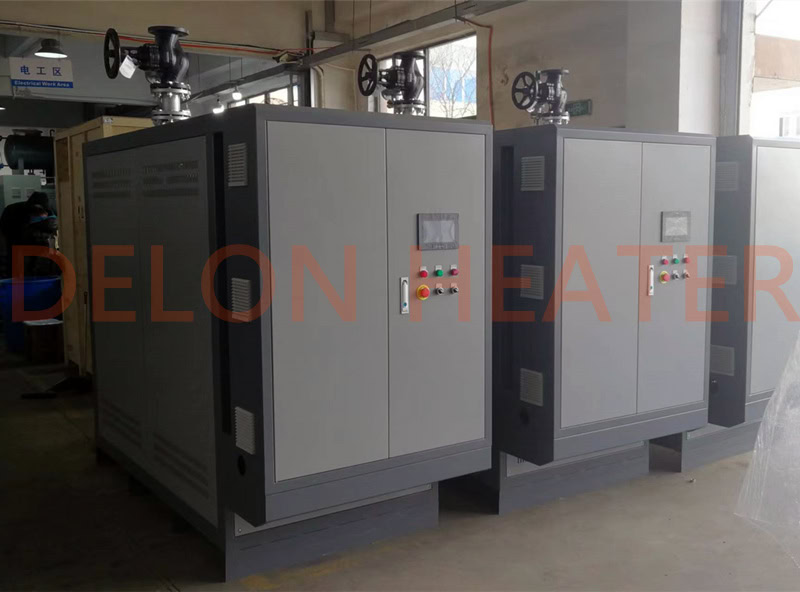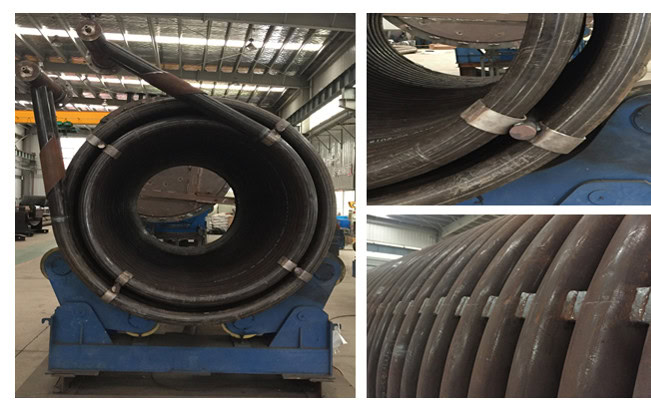
With the progress of technology and process development, we have more and more demand for thermal oil heater, which is also be called heat-conducting oil boiler. It is a kind of boiler using organic heat carrier for heating. It mainly through fuels to convert its energy into heat energy, organic heat interceptor (thermal oil) as the heat transfer medium to heat the boiler, with the features of small heat loss, significant energy-saving effect, good environmental protection effect, low-pressure and high temperature, etc. Next, come with me to take a look.
What Is A Thermal Oil Heater?
Thermal oil heater is using heat conduction oil as heat carrier, also called organic heat carrier or heat medium oil. It is fueled by electricity, fuel oil (light diesel, heavy oil), combustible gas, coal or other combustible materials. It’s the once-through type special industrial furnace that using the circulating oil pump to force the liquid phase circulation, the heat energy will be delivered to the heat-using equipment, and then return to reheat it. Furthermore, it is a complete circulating heating system.
What Is the Working Principle of Thermal Oil Heater?
Thermal oil heater is a boiler that takes electricity, coal, fuel oil, gas, etc. as energy source, converts fuel energy into heat energy, takes organic heat carrier (heat-conducting oil) as heat transfer medium, compulsorily circulates heat-conducting oil in the system through high-temperature oil pump, so that it is heated week by week, to meet the boiler that requires heat equipment to obtain the required heat energy continuously, and can meet the process temperature set in the production process as well as High precision temperature control is required.
The thermal oil boiler is usually composed of the main parts (heating body, high-temperature oil pump, burner or heating elements), oil storage tank, expansion oil tank, electric control box, pipeline, etc., as a complete set of equipment, which is assembled together with the heat-using equipment to form a mandatory liquid-phase circulation heating system. It is a high-efficiency and energy-saving heating equipment in petroleum, chemical, electronic textile, printing and dyeing, food, plastic, film and other industries.
What Does A Thermal Oil Heater Do?
Compared with the use of steam heating, heat-conducting oil furnace has been widely used as a heat transfer medium in modern industrial production because of the use of heat-conducting oil heating, both uniform heating, simple operation, safety and environmental protection, energy saving, high precision temperature control, low operating pressure and other advantages. The principle of heat-conducting oil furnace is that the furnace is a closed-circuit cycle, the difference between the oil temperature and the return oil temperature is only 20-30 °C, which means that only the temperature difference of 20-30 °C of heating can reach the use temperature. While, the steam boiler is normally using cold water, which is heated into steam to heat the equipment, and the steam becomes 60-70 °C of condensate discharge. So, it plays the role of energy saving and consumption reduction.
What Are the Applications of Thermal Oil Heaters?
a) Chemical: Polymerization, condensation reactions, evaporation, melting. Oil and fat: decomposition, deodorization, fatty acid distillation, heating, hydrogenation reaction, esterification.
b) Petrochemical: Synthesis, reaction, distillation, distillation, heating, holding.
c) Plastic, rubber: Hot pressing, calendaring, extrusion, vulcanization and molding, artificial leather processing.
d) Textile, printing and dyeing: Heat setting, drying, baking.
e) Fibers: Cyaniding melting, impregnation, blending, molding.
f) Atomic energy industry: Nuclear fuel processing.
g) Paper printing: Heat melting, corrugated board processing, paper, drying.
h) Wood: Hot pressing, drying.
i) Metal: Pickling, electroplating, painting, oil bath, heat treatment.
j) Painting: Coating and baking drying.
k) Vehicles, aircraft: Heating and forming, high-temperature bonding, and drying.
l) Construction: Highway asphalt
What Are the Features of Thermal Oil Heater?
1. Thermal oil boiler is a once-through type special boiler developed based on the design thinking of forced circulation.
2. Closed-loop heating, connected to the atmosphere, it can extend the service life of the boiler, liquid-phase heat transport, small heat loss, significant energy saving and good environmental protection.
3. Thermal oil boiler adopts three-pass coil design, and this once-through structure determines the safety that traditional boilers do not have.
4. Because of the coiled tube structure, the heating surface is sufficient, which makes it have high thermal efficiency.
5. Thermal oil boiler, the remarkable feature is counter-current heat transfer, the temperature difference between combustion exhaust and thermal conductive oil outlet is below 30 ℃.
6. Thermal oil heater of its remarkable structure, mainly operating at a lower pressure to obtain a working temperature of 400 ℃ or less, with low pressure and high temperature.
7. Thermal oil heater can meet the process requirements of heating and cooling at different temperatures in a wider temperature range, or use the same heat-conducting oil in the same system to achieve the process requirements of high-temperature heating and low-temperature cooling at the same time.
What Are the Common Types of Thermal Oil Boiler?
1. Coal Fired Boiler

This kind of thermal oil boiler is fueled by coal, heat-conducting oil as the heat carrier. Generally divided into vertical hand-fired, horizontal barrel type, horizontal chain burned three forms of coal-fired structure, mainly according to the labor intensity of adding coal thus divided into these three forms.
2. Oil (Gas) Fired Boiler

This thermal oil boiler is fuel oil or gas as fuel, the use of burners to burn fuel, heat-conducting oil as the heat carrier. Generally divided into vertical and horizontal structural forms, the selection is mainly based on the height of the boiler room.
3. Electric Heating Boiler

For the electric heating thermal oil boiler (heater), heat is generated and transmitted by the electric heating elements which is diffused into the heat-conducting oil, using the heat-conducting oil as the medium, by use of circulation pump, forcing the heat-conducting oil to circulate in the liquid phase, transferring the heat to one or more kinds of heat-using equipment, after being printed by the heat-using equipment, re-passing the circulation pump, going around to the heater, absorbing the heat again and transferring it to the heat-using equipment, so on and so forth, realizing the continuous transmission of heat, making the heated object to The temperature of the object to be heated rises to meet the heating process requirements.
What Parts Are Included in a Thermal Oil Heater?
1. Furnace Body (For Oil and gas fired boilers)

a) No oil collection plate structure, no dead angle to the flow of thermal medium oil, to prevent the risk of oil leakage due to the high pressure of oil collection plate breakage.
b) Three-layer boiler shell insulation, with inner layer of ceramic fiber, middle rock wool board and outer covering of lightweight cement, to reduce heat loss and improve the strength of the outer package.
c) The combustion chamber manhole provides quick inspection and maintenance; with a flame viewing window, the combustion condition can be clearly monitored; the quick-opening door cover provides quick inspection and maintenance, and the special structure has no smoke leakage problem.
d) With explosion-proof port to prevent the ignition of the furnace chamber from bursting and unloading pressure in time.
2. Burner (For oil and gas fired boilers)

a) When the boiler outlet oil temperature is lower than the set limit rate of the outlet oil temperature and the differential pressure between the inlet and outlet oil is normal, automatically start the burner one-stage fire and two-stage fire.
b) When the boiler outlet oil temperature is higher than the set upper limit of outlet oil temperature -5℃, turn off the burner two-stage fire and keep the state of one-stage fire.
c) Turning off the burner one-stage fire and two-stage fire when the boiler outlet oil temperature is higher than the set upper limit of the outlet oil temperature.
If it is a proportional regulating burner, it will automatically adjust and control the output and temperature.
3. Heating Elements (For Electric Thermal Oil Heater)

The heating element we use is designed according to the European standard, the U-section tube is made of 1.4414 (SUS316L), the heating cord is made of F321 stainless steel imported from Sweden, and the filling electric heating powder is high temperature type magnesium oxide imported from Japan.
4. Electric Control Box

a) Designed in accordance with PED, ASME and GB standards.
b) Intelligent Human Machine Interface system by PLC with touch screen.
c) The electrical components are from Siemens, Schneider, Omron and other international famous brands.
d) Optional design for the Ex-proof standard (ATEX / IEC Ex).
5. Oil Filling Pump

a) Automatically start the oil filling pump when the oil level of the head oil tank is low.
b) When the oil level of the head oil tank is high, the oil filling pump is automatically turned off.
6. Oil Circulation Pump

a) When the system is on duty, turn on the circulation pump until it is turned off after the system is off duty.
b) When the system is off duty, turn off the circulation pump when the outlet oil temperature is lower than 100℃ and the difference between the inlet and outlet oil temperature is less than 20 ℃.
7. Oil Delivery Pump

a) Automatically start the oil delivery pump when the level of daily oil tank is low.
b) When the level of daily oil tank is high, automatically shut down the oil delivery pump.
How to Purchase A Thermal Oil Heater?
Here are some tips to guide you by the process:
a) Firstly, determining what thermal oil heater you will be using. There are different heaters for different usages.
b) Secondly, considering the heating power/thermal capacity of the heater. If you have no ideal about how to select the models, I will give the suggestions with our engineers.
c) Thirdly, taking into account the features offered by different models. Some heaters come with additional features that could be beneficial for your heating or cooling needs.
d) Finally, comparing prices to find suitable suppliers that meet your budget. Thermal oil heaters (boilers) can range in prices, so it is important to find one that meets your needs without losing the money.



